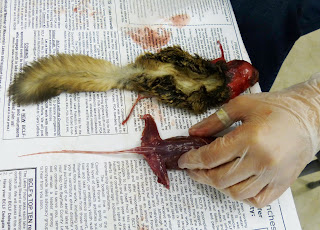On Preserving Mammals of "Flight"
Gliding through the crisp, dark air on moonlit nights, flying squirrels frequently escape the gaze of their diurnal neighbors. It's quite a pity that we don't encounter them more, for not only are Wisconsin's two flying squirrel species simply adorable with those large, dark eyes, but understandably intriguing rodents as well. What other mammals can descend down to backyard feeders so elegantly? How many others engage in a mutually beneficial relationship with the fungi of our forests, and in turn facilitate growth of the same trees they launch from?
To my dismay, the only times I have yet gazed upon a flying squirrel were as they rested lifelessly within the Museum. One had been crouched in collection storage for some time, while the other recently came in just hours after falling prey to a house cat. She was brought in by our director, a tad bloodied by fatal bite wounds yet otherwise nearly as pretty as she would have been in life. As a result, she soon became my very first mammal taxidermy experience.
Small mammals work great as practice material. They are readily available and should, ideally, take little time. I approached taxidermy of this particular flying squirrel interested in highlighting her patagium--the membrane of skin extending from her wrists to ankles which allowed her to glide between trees in life.
 |
| A flying squirrel's patagium creates glide, while its tail provides stability. |
I made my first incision from the base of the neck to the tail, exposing the inner abdomen--having a patagium means that a flying squirrel becomes quite roomy inside once abdominal organs are removed. Before completely separating those inner bits from the skin, I was briefed on the task of slipping bones out from the bushy tail. "Now..." my mentor John paused for a moment during instruction and took on a serious tone, "you need to get a good grip, then pull really hard." I didn't always know when he was being serious, but yet was always intimidated when he took on that inflection. I pinched with one hand, used the other to pull from where the spinal vertebrae were nestled among muscle and organs, and miraculously, off came that tail with the ease of pulling off a loose sock! I was proud of myself but tried not to let it show too much.
 |
| Wanting to display the pearly-white underbelly, the abdominal incision was made along the squirrel's back. |
As with bird taxidermy before, I was amazed by the anatomy of this flying squirrel. She had so much skin! Having successfully pulled out inner tissue, having clipped away leg muscles from their respective bones, and sliding off that tail, I had to remove the skull. From the base of the head, I pulled skin up to the eyes where I carefully snipped without damaging the lids to those big, gorgeous eyes. I pulled up farther, and once more was very careful as I maneuvered her little nose away from the skull.
For this project, the actual skull would be used for the mount so it needed to be cleaned. All tissues were scraped, scrambled, and swabbed out and the skull further cooked clean over a hot plate. The smell was ghastly. It was necessary, though, and after boiling the skull, I more readily handled the squirrel's remains without gloves, expressions of disgust, or feigning of nausea.
 |
| Photos, or notes, on placement of small pieces like teeth should be taken prior to boiling so as to reposition if they come out during the process. |
Now, the process likens that of sculpting. Wires help to position limbs in relation to their now Styrofoam bodies, as the taxidermist's imagination runs as wild as the squirrel's existence once was. Tonight I will complete my work of replicating her animate energy via taxidermy. I will attempt to do her justice by displaying her so that visiting children will marvel at how she is objectively cuter than their pet gerbil. Adults will hopefully connect this animal to human innovation in the world of base jumping, or they too will find her cute enough to protect others in their forests. As I work, I will do so with the hope that she will soon inspire us even in death. Even later tonight, as I slump into my cozy bed with a view of tall hemlocks and glistening stars, I will imagine her kin gliding above my roof, safe from house cats for another night.



